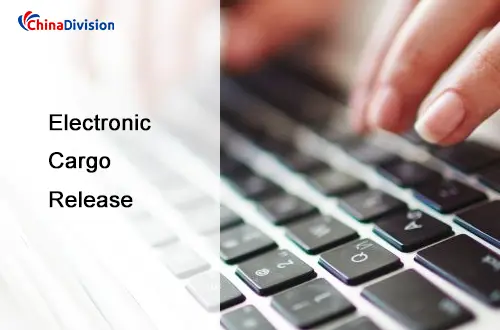Electronic Cargo Release Usage Process and Acquisition
It is not uncommon for goods to arrive at the port but cannot be picked up because the bill of lading has not arrived. In order to solve this pain point, Electronic Cargo Release, especially Telex Release, has become an indispensable key link in modern logistics.
Table of Contents
Rapid transportation and delivery of goods can not only improve customer satisfaction, but also reduce operating costs. As an international warehousing and fulfillment service provider, we are well aware of the pain points and needs of B2B companies and e-commerce sellers in cargo transportation. Today, let us deeply analyze the use process, acquisition method and related fees (such as EDI Fee) of Telex Release to help e-commerce sellers and B2B companies complete cargo delivery efficiently and safely.
What is Electronic Cargo Release?
As a certificate of ownership of goods, the circulation speed of bills of lading often becomes a key factor restricting the efficiency of cargo delivery. Electronic Cargo Release refers to the operation method of authorizing the destination port agent to release the goods electronically without submitting the original bill of lading. The most common form is Telex Release, that is, the carrier or its agent notifies the destination port to release the goods by email or EDI system after receiving the original bill of lading returned by the shipper.

Especially in near-sea transportation, such as routes from Shanghai to Japan and South Korea, the shipping period is short, but the mailing or bank delivery process of the bill of lading may take a long time, resulting in the inability to pick up the goods in time after the goods arrive at the port, increasing the demurrage and storage costs. At this time, Electronic Cargo Release (ECR) came into being. It quickly transmits bill of lading information electronically to achieve immediate release of goods, greatly shortening the delivery cycle and reducing operating costs.
Electronic Cargo Release Usage Process
1. Submit an application
The shipper needs to submit an ECR application to the freight forwarder or shipping company, clearly stating that it hopes to use the electronic release method. At the same time, the shipper needs to sign a telex release guarantee letter to indicate that it is responsible for all responsibilities and consequences arising from the telex release operation.
2. Review and confirmation
After receiving the application, the freight forwarder or shipping company will review it and confirm the identity and bill of lading information of the shipper. Once the review is passed, the shipper needs to return the original bill of lading that has been issued (or declare it invalid), or sign a letter of guarantee as required by the shipping company.
3. Electronic release notice
The shipping company will send an electronic release notice to the destination port agent through email, system instructions, etc., informing that the goods have been released by ECR and no paper bill of lading is required.
4. Consignee picks up the goods
The consignee can go directly to the destination port agent with his identity certificate and arrival notice to handle the pick-up procedures without showing a paper bill of lading.
Notes on obtaining Electronic Cargo Release
Shipping company policy
Not all shipping companies provide ECR services, and the policies of different shipping companies may vary. Therefore, when booking, the shipper needs to clearly ask the shipping company whether it provides ECR services and understand the relevant fees and operating procedures.
Destination restrictions
Some countries and regions have restrictions on ECR services. For example, some African countries may require paper bills of lading. Therefore, before choosing ECR services, shippers need to understand the relevant policies and requirements of the destination.
Cost considerations
Although ECR services can significantly shorten delivery cycles, they may also incur additional fees, such as Telex Release Fees. Shippers need to clarify the fee details when booking to avoid subsequent disputes.
What is EDI Fee (Electronic Data Interchange Fee)?
EDI Fee (Electronic Data Interchange Fee), also known as Telex Electronic Cargo Release Fee, refers to the fees incurred by carriers or freight forwarders when sending release instructions electronically. EDI is an encrypted, secure server-to-server file exchange method that replaces traditional paper processing and order monitoring methods. The fee usually includes:
Data transmission cost: sending release information through EDI system or email
System maintenance and operation fee: used to support the operation of electronic release system
Manual processing fee: including labor costs of review, confirmation, notification and other processes
Note: EDI Fee charging standards may be different for different carriers or freight forwarders. It is recommended to confirm clearly before booking.
How does telex release work?
Cargo loading and bill of lading issuance: When the goods are loaded, the freight forwarder or carrier issues the original bill of lading.
Payment and telex release request: After payment, the shipper hands over the original bill of lading at the port of departure and requests telex release.
Electronic notification: The carrier sends an electronic message to the port of destination, instructing it to deliver the goods to the consignee.
Release without original bill of lading: The consignee presents his identity certificate and collects the goods without paper bill of lading.
In-depth analysis of EDI Fee: Common user questions and answers
How to reduce EDI Fee?
Optimize transaction volume: Reduce transaction volume by reducing unnecessary document exchanges, thereby reducing EDI Fee.
Choose a cost-effective service provider: Compare the fees and service levels of different EDI service providers and choose a cost-effective service provider.
Take advantage of free resources: Some EDI service providers provide free software or training resources, and enterprises can make full use of these resources to reduce costs.
What is the difference between Telex Release and original bill of lading?
The original bill of lading is a transferable certificate of title and requires physical delivery; Telex Release is a non-transferable electronic authorization, which is suitable for trade scenarios that do not require resale.
What is the relationship between EDI Fee and Electronic Cargo Release?
Although EDI Fee is not directly related to Electronic Cargo Release, EDI technology is one of the important means to achieve ECR services. Through EDI technology, shipping companies can quickly and accurately transmit electronic release notices to achieve immediate release of goods. Therefore, when choosing ECR services, shippers need to consider whether the shipping company adopts EDI technology and understand the related costs.
Is Telex Release safer?
Compared with mailing the original bill of lading, electronic release can avoid risks such as document loss and delay; but it is necessary to ensure that all original bills of lading have been returned to avoid the risk of duplicate release.
Is Telex Release applicable to all countries?
Telex Release is not applicable to all countries. Some countries may not support electronic release services due to legal or regulatory requirements. For example, countries such as Venezuela, Angola, and Mozambique do not support Telex Release.
How can Chinadivision help you with your electronic release process?
As a professional international warehousing and fulfillment service provider, Chinadivision is well aware of the pain points and needs of B2B companies and e-commerce sellers in cargo transportation. We provide a full range of international freight services including Electronic Cargo Release to help you complete the transportation of goods quickly and efficiently. Whether it is booking, customs declaration, warehousing or distribution, we can provide you with a one-stop solution.
With Chinadivision's fulfillment services, you can enjoy the following advantages:
Professional team: Our team members have deep knowledge and experience in the logistics industry and can provide you with professional advice and services.
Advanced technology: We use advanced logistics management systems to ensure that your cargo information is updated in real time, so you can track it at any time.
Customized solutions: According to your specific needs, we can provide you with customized logistics solutions to meet your personalized needs.
If you have any questions about Electronic Cargo Release or EDI Fee, or need professional international freight services, please feel free to contact Chinadivision. Our professional team will wholeheartedly answer your questions and provide customized solutions to make your international freight journey smoother!





